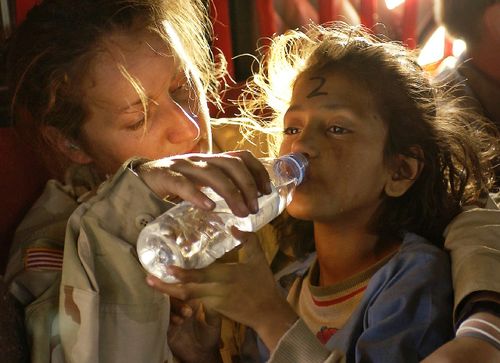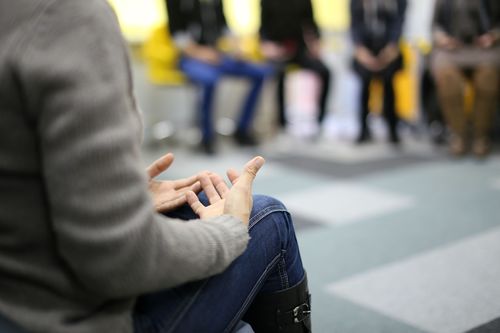Original Editor – Your name will be added here if you created the original content for this page.
Top Contributors – Karen Wilson and Kim Jackson
Introduction
Individuals who have experienced torture and severe trauma are found throughout the international community. Among the most vulnerable are persons who have been forcibly displaced from their homes. According to the UNHCR[1], this includes 25.4 million refugees, 40 million internally displaced persons, and 3.1 million asylum-seekers. Before and during flight, many forcibly displaced individuals experience traumatic events such as imprisonment, torture, loss of property & livelihood, physical abuse, separation from family, and malnutrition.[2] These conditions can result in serious physical and psychological harm.
As the population of forcibly displaced persons continues to grow,[1] so does the reach of its social, physical, and psychological consequences. As a result, physical therapists are increasingly likely to work with patients who have experienced severe trauma or torture. In order to meet the comprehensive rehabilitation needs of this population, it’s imperative that physical therapists be aware of and address special considerations for patient care.
The Physical and Mental Impact of Torture and Trauma
Trauma refers to any event that is experienced as being emotionally harmful and has a lasting negative impact on an individual’s well-being.[3] Torture is a specific type of trauma in which mental or physical suffering is purposely inflicted to punish, coerce, or intimidate a person or third party.[4] Methods of torture include beatings, suspension, forced positions, strapping, electroshock, and sexual violence. The nature of these methods make injury to the musculoskeletal, neurological, and integumentary systems common.[5]Post-traumatic stress disorder (PTSD), depression, and anxiety are psychological sequelae that may persist well after physical wounds have healed. Moreover, ongoing psychological stress can manifest in the form of chronic somatic pain.
General Considerations
In light of the physical consequences of trauma and torture, physical therapy is an important part of recovery for survivors. A [3] The table below outlines a list of considerations and strategies for establishing a therapeutic treatment environment:
Strategies to Avoid Client Re-traumatization
| Consideration | Strategies | |
|---|---|---|
| Language and Culture | English may not be the client’s first language. |
|
| Sensitivity to working with individuals of the opposite sex. |
|
|
| Trust | Fear of being let down. | |
| Fear of loss of privacy. |
|
|
| Safety | Certain positions, settings, equipment, or treatment interventions can provoke discomfort and flashbacks. |
|
| Sensitivity to prolonged questioning and interrogation. |
Assessment
While there is no limit to the impairments and functional limitations that trauma can cause, patterns in symptoms may exist. The following is a collection of common findings that may be noted during the history taking and examination process:[5][6][7]
- Headaches
- Chronic pain of the joints and muscles
- Changes in vision
- Dizziness
- Postural impairments
- Sleep disturbances
- Muscle tension and weakness
- Muscular imbalances
- Decreased mobility
- Inability to perform activities of daily living
- Impaired self-regulation (ex. breathing rate & pattern, energy levels, and relaxation)
- Impaired sensation and body awareness
Further insight into client presentation can be gleaned from injury context and comorbidities. In particular, psychological conditions and maladaptive coping strategies can modulate how clients experience pain and other symptoms impacting function.[5][7] For instance, while [5] Thus, screening for psychiatric symptoms and affective barriers, like depression and [7] If positive, referral for psychological support (ex. counseling & psychotherapy) is warranted.
Treatment
Physical therapy intervention should emphasize empowerment and collaboration. Clients should be partners in determining the acceptability and progression of techniques, especially in the case of electrical equipment and hands-on techniques that may trigger re-traumatization.[5] When in doubt, the use of potential triggers should be deferred to maintain client trust and safety. Group sessions, self-regulation, and relaxation training are interventions that may complement traditional physical therapy sessions well.[5][6][7]
Ongoing education and home exercise programs are instrumental in promoting self-efficacy. For those experiencing chronic pain, pain science is key for re-framing clients’ understanding of movement and painful stimuli.[7] However, in teaching self-management strategies, physical therapists must account for psychosocial factors that impact adherence.[6] Outside of physical and psychological recovery, many forcibly displaced persons are also dealing with financial and legal problems, unsatisfactory living conditions, adaptation to a new culture, family separation, and religious, racial and/or ethnic hostilities. Complex clinical and social circumstances may slow the rehabilitation process significantly.[6] These conditions may necessitate more modest goal setting and criteria for client progress.
Conclusion
System or organization wide measures should be implemented to give physical therapists the flexibility and support needed to effectively work with forcibly displaced persons and survivors of trauma and torture.[6] Doing so is essential to promote healing in a sustainable and patient-centered manner.
Further Reading
References
- ↑ 1.01.1 UNHCR. Refugee Statistics [Internet] Washington, D.C.: UNHCR [Cited September 29, 2018]. Available from: ↑ Refugee Health Technical Assistance Center. Traumatic Experiences of Refugees [Internet]. [Cited September 29, 2018]. Available from: ↑ 3.03.1 SAMHSA’s Trauma and Justice Strategic Initiative. SAMHSA’s Concept of Trauma and Guidance for a Trauma-Informed Approach. Rockville, MD: Office of Policy, Planning and Innovation, Substance Abuse and Mental Health Services Administration; July 2014
- ↑ United Nations. Convention against torture and other cruel, inhuman or degrading treatment or punishment. New York, 10 December 1984
- ↑ 5.005.015.025.035.045.055.065.075.085.095.105.11 Gueron, LP. ↑ 6.006.016.026.036.046.056.066.076.086.096.106.116.126.13 Franklin C. Physiotherapy with Torture Survivors. Physiotherapy Journal, 87 (7): 374-377, July 2001
- ↑ 7.07.17.27.37.4 Dee J & Gamble A. function gtElInit() { var lib = new google.translate.TranslateService(); lib.setCheckVisibility(false); lib.translatePage('en', 'pt', function (progress, done, error) { if (progress == 100 || done || error) { document.getElementById("gt-dt-spinner").style.display = "none"; } }); }
Ola!
Como podemos ajudar?



